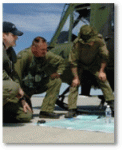Despite the quality of my Syracuse journalism program, I probably learned even more about communication as a young second lieutenant back in the early 1980’s.

If you like simplicity, you can’t do much better than the five-paragraph field order. Designed for small combat-unit leaders, it provides a way to plan and communicate under pressure that translates well to the business world. Through this format, you can explain a mission and describe the plan for accomplishing that mission. For those of you who like acronyms, it’s SMEAC and breaks down like this:
- Situation: What’s the current situation, issue, or problem that we need to resolve? Who are your friends and who are your enemies? And who’s around that can help you? In military terms, it’s enemy forces, friendly forces, and attachments/detachments).
- Mission: What do we have to accomplish? Use the journalistic five W’s (who, what, where, when, and why). If you can answer all five W’s, you — and your people — should understand the mission.
- Execution: Here’s how we’re going to accomplish our mission? Define it in detail and make sure everyone understands their roles. You’re breaking down tasks and assignments. Include a time frame for accomplishing each task and who’s responsible.
- Administration and logistics. The military calls this service support, but it’s basically a list of the resources that we have to accomplish our mission and who is providing that support.
- Command and Signal: How will we communicate and who’s in charge? This will include project deliverables, timetables for updates, and knowing who to go to if you need help or approval. The military version stresses things like frequencies and call signs, pyrotechnics, passwords and code words along with the chain of command.
In recent weeks, I’ve watched a podcast with David Meister (The Trusted Advisor) favorably comparing military experience to a Harvard Business School degree and read a terrific Harvard Business blog by Col. Tom Kolditz about Why The Military Produces Great Leaders. It reminded me that many of my business successes were due to getting the opportunity to lead 50+ people right out of college. As a result, I was able to take on additional responsibilities (e.g., moving from reporter to editor) without having to worry about whether I could handle the people-management part.
Being good at the five-paragraph field order requires practice and a commitment to using it on a consistent basis. You can use it to communicate a mission to your own “troops,” to create marketing and communications plans, and to help your preparation for negotiations.
There’s enough here for you to get started, and I can help as part of my consulting business if you’re interested. Good luck!
Peter,
Not being in the military (medical exemption) I am hard pressed to comment on what works from a military perspective. However, from a communications perspective I would offer a few insights for you to consider.
In “traditional media” this works great – good way to organize thinking and distribution of information. In a “social media” world this doesn’t work as well. This world is all about NOW and real-time and short snippets of information that the audience and “hit and run” with as they search lots of content on the web.
Blog postings for example that focused on these 5 elements in each post would most likely discourage readers and cause followers to defect. However, if you talked about each one in a different post, you would probably get people coming back to read more about it. Something to think about…
Blaine
http://www.someexec.com
Blaine,
I think you’re absolutely right about breaking these kind of things down into more manageable pieces. As I try to build a readership, however, I can’t assume that people will get back to these pages five times. Continuity is a challenge. As time passes, I will focus on individual components and link back to the original article. Thanks for taking the time to comment though and I appreciate the great advice.
— Peter